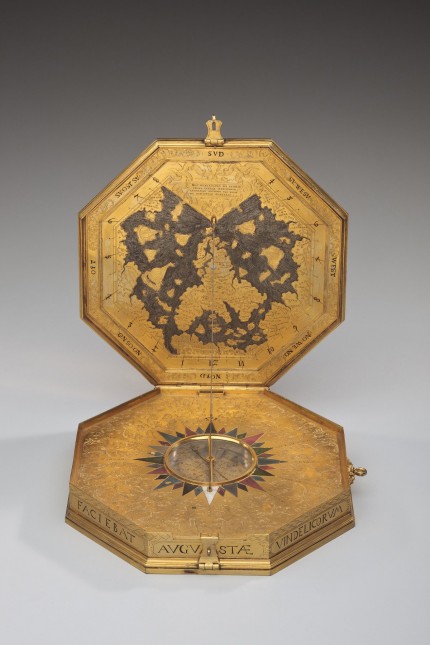Germany giveth and Germany taketh away. Last month the Toledo Museum of Art (TMA) announced it had acquired Napoleon’s brother’s exquisite spiral chandelier from a Hamburg art dealer. Two days ago the museum announced it would voluntarily return an exquisite 16th century astronomical instrument to the Gotha Museum in Germany after being presented with evidence that the object had been stolen from the museum after World War II.
The instrument is a multi-use device known as an astrological compendium made by Augsburg craftsman Christopher Schissler in 1567.
Schissler was considered the greatest of Augsburg’s instrument makers, crafting pieces of the highest quality from precious materials for the likes of August I, the Elector of Saxony, and Rudolf II, Holy Roman Emperor. Only around 100 instruments made by Christopher Schissler are known to have survived. This particular one was made for the Kunstkammer of Rudolf’s court in Prague. Rudolf was fascinated by mechanical devices and gave Schissler, along with other top instrument makers, access to court astronomers so they could be apprised of the latest research. He supported them financially and encouraged them to develop new designs and mechanisms.
This device is very much a show-off piece, a showcase for its owner’s wealth and scientific knowledge. Made from gilded bronze and enamel, it’s an astrolabe, but it also has a variety of other functions. The outside cover is a sun dial, the inside cover a map of the world from which a plumb-bob can be hung to calculate angle of inclination. Interior compartments include a wind rose, a compass, a lunary (a device to calculate the time based on the moon), a perpetual calendar and a zodiac showing which signs govern which days. It is inscribed along its octagonal edges “CHRISTOPHORUS SCHISSLER FACIEBAT AUGUSTAE VINDELICORUM – ANNO DOMINI 1567” (Christopher Schissler made this, Augsburg ― Anno Domini 1567).

The Schissler Compendium remained in Prague Castle until 1620 when it was taken as plunder by the forces of Maximilian I, Elector of Bavaria, after their victory against Frederick I, King of Bohemia, at the Battle of the White Mountain, one of the early clashes of the Thirty Years’ War. It was taken to Munich. Twelve years later, it was plundered again, this time by King Gustavus Adolphus of Sweden who invaded Bavaria and in May of 1632, took Munich. Gustavus Adolphus died in battle later that year and after his ally Bernhard of Saxon-Weimar died in 1639, the spoils from Bavaria were divided among the survivors. The Schissler Compendium went to Bernhard’s brother Ernest I, Duke of Saxe-Gotha, who installed it in his collection at Gotha.
Inventory records from the 19th century indicate the instrument stayed put in the collection of the Dukes of Gotha at Friedenstein Castle for 300 years. When the palace was converted to a museum, the compendium went on display alongside a larger astrolabe by Schissler. Much of the collection was moved during World War II for safekeeping and returned after the war was over. Thuringia was occupied by American forces for a few months after the end of the war, and then the Soviets took over. They took many of the Gotha Museum treasures to the Soviet Union only to return them after the establishment of the German Democratic Republic (East Germany) in 1949. We know that the Schissler Compendium was not among the art and artifacts returned to the museum by the Soviets.
So somewhere in the chaos of wars world and cold, the instrument made its way to New York art dealers and thence to Toledo, Ohio. The Toledo Museum of Art had no knowledge of its checkered past until May of 2013 when Dr. Martin Eberle, director of the Gotha Museum, wrote them a letter about the astrolabe. He included considerable documentary and photographic evidence that Toledo’s Schissler Compendium and the Gotha Museum’s Schissler Compendium were the same piece. After a couple of months spent reviewing the documentation, TMA Director Dr. Brian Kennedy wrote back to Dr. Eberle acknowledging that it seemed their astrolabe was the one stolen from the German museum.
The institutions negotiated for a year after that, planning the repatriation of the object and the loan of artifacts from the Gotha collection to the Toledo Museum of Art in exchange. They still haven’t decided which pieces will be loaned, but they’ll sort that out in due course. Meanwhile, repatriation is nigh, tentatively scheduled for March or April of this year.
Kudos to the TMA for returning the piece. There’s no legal requirement that they do so. The UNESCO Convention on the Means of Prohibiting and Preventing the Illicit Import, Export and Transfer of Ownership of Cultural Property does not apply, nor do the protocols regarding Nazi loot. This was entirely an ethical choice they made because they think it’s the right thing to do.
[U]nlike earlier cases, this is one that involves no government bureaucracy or complications raised by potential thieves or distributors awaiting trial. It is, as Mr. Kennedy noted, simply an agreement between two museums to get a historically valuable piece back to its rightful owner.
“We’ve recognized there’s been a cultural shift in how museums conduct themselves,” Mr. Kennedy said. “There’s much more scrutiny in how museums obtain their objects and transparency now.”
He said the TMA had made it museum policy over the past 10 years to look harder into the ownership history of every piece.
“This was a one-of-a-kind scientific device,” Mr. Kennedy said. “It’s sad to see it go, but it’s not ours.”